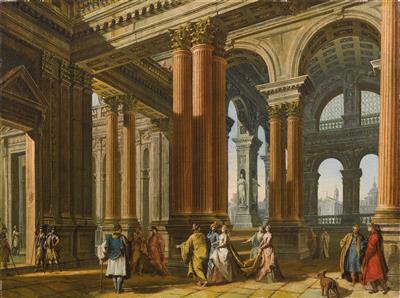Antonio Joli

(Modena 1700–1777 Naples)
Architectural capriccio with figures,
oil on canvas, 76 x 57 cm, framed
We are grateful to Ralph Toledano for confirming the attribution of this painting based on a high-resolution digital photograph and for his suggestion that the figure painter was most likely Sebastiano Ceccarini (Fano 1703–1783).
We would also like to thank Dario Succi, who independently confirmed the attribution of the present painting to Antonio Joli. He dated it to ca. 1740 and suggested Gaspare Diziani (Belluno 1689–1767 Venice) as the painter of the incidental figures.
The present painting recalls a report by Baldassarre Orsini (B. Orsini, Guida al Forestiere per l’Augusta Città di Perugia, Perugia 1784, p 104) describing a painting located in Perugia in 1784: „Nel palazzo del nobil Signor Donnini..prospettiva dal Gioli, colle figure di Sebastiano Ceccarini“ [„At the palace of the Nob. Signor Donnini (there is) a view by Gioli with figures by Sebastiano Ceccarini“].
According to Toledano, the present composition may be the ricordo of an opera stage set, possibly Semiramide riconosciuta. The aspect of the vestibule of an ancient palace, decorated with statues and pilaster strips, resembles other capriccios by Joli, echoing his work as a stage designer. The present painting conveys the cheerful and playful atmosphere of the world of Italian opera and is comparable to similar works by Joli (cf. R. Toledano, Antonio Joli. Modena 1700–1777 Napoli, Turin 2006, C.VII, C.VIII, C.IX and C.X, p 98–101).
As a set painter, Joli was influenced by the Galli da Bibiena family of painters. He worked for the preeminent opera houses in Venice and London before being summoned to the court of Ferdinand VI. of Spain and Barbara of Portugal in Madrid. In later years, he also worked for the Teatro San Carlo in Naples. Given the transitory nature of stage set painting, by which Joli became famous at his time, capriccios such as the one at hand are all that remains today – a tangible reminder of an ephemeral work, conveying the elegant and refined culture of the 18th century.
21.04.2015 - 18:00
- Prezzo realizzato: **
-
EUR 47.500,-
- Stima:
-
EUR 30.000,- a EUR 40.000,-
Antonio Joli
(Modena 1700–1777 Naples)
Architectural capriccio with figures,
oil on canvas, 76 x 57 cm, framed
We are grateful to Ralph Toledano for confirming the attribution of this painting based on a high-resolution digital photograph and for his suggestion that the figure painter was most likely Sebastiano Ceccarini (Fano 1703–1783).
We would also like to thank Dario Succi, who independently confirmed the attribution of the present painting to Antonio Joli. He dated it to ca. 1740 and suggested Gaspare Diziani (Belluno 1689–1767 Venice) as the painter of the incidental figures.
The present painting recalls a report by Baldassarre Orsini (B. Orsini, Guida al Forestiere per l’Augusta Città di Perugia, Perugia 1784, p 104) describing a painting located in Perugia in 1784: „Nel palazzo del nobil Signor Donnini..prospettiva dal Gioli, colle figure di Sebastiano Ceccarini“ [„At the palace of the Nob. Signor Donnini (there is) a view by Gioli with figures by Sebastiano Ceccarini“].
According to Toledano, the present composition may be the ricordo of an opera stage set, possibly Semiramide riconosciuta. The aspect of the vestibule of an ancient palace, decorated with statues and pilaster strips, resembles other capriccios by Joli, echoing his work as a stage designer. The present painting conveys the cheerful and playful atmosphere of the world of Italian opera and is comparable to similar works by Joli (cf. R. Toledano, Antonio Joli. Modena 1700–1777 Napoli, Turin 2006, C.VII, C.VIII, C.IX and C.X, p 98–101).
As a set painter, Joli was influenced by the Galli da Bibiena family of painters. He worked for the preeminent opera houses in Venice and London before being summoned to the court of Ferdinand VI. of Spain and Barbara of Portugal in Madrid. In later years, he also worked for the Teatro San Carlo in Naples. Given the transitory nature of stage set painting, by which Joli became famous at his time, capriccios such as the one at hand are all that remains today – a tangible reminder of an ephemeral work, conveying the elegant and refined culture of the 18th century.
|
Hotline dell'acquirente
lun-ven: 10.00 - 17.00
old.masters@dorotheum.at +43 1 515 60 403 |
| Asta: | Dipinti antichi |
| Tipo d'asta: | Asta in sala |
| Data: | 21.04.2015 - 18:00 |
| Luogo dell'asta: | Wien | Palais Dorotheum |
| Esposizione: | 11.04. - 21.04.2015 |
** Prezzo d'acquisto comprensivo di tassa di vendita e IVA
Non è più possibile effettuare un ordine di acquisto su Internet. L'asta è in preparazione o è già stata eseguita.
